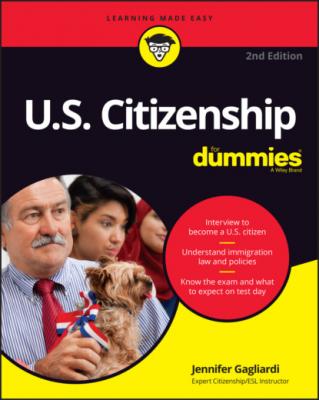U.S. Citizenship For Dummies. Jennifer Gagliardi
Чтение книги онлайн.
Читать онлайн книгу U.S. Citizenship For Dummies - Jennifer Gagliardi страница 19
 posts around the world, including embassies, consulates, and missions to international organizations.
posts around the world, including embassies, consulates, and missions to international organizations.
To be sure, the State Department has many important duties, including providing support for U.S. citizens at home and abroad; helping developing countries grow strong, stable economies and governments; bringing nations together to address global concerns; and combating threats like terrorism, international crime, and narcotics trafficking. But the State Department also provides many services to U.S. citizens traveling and living abroad through many offices, including the State Department’s Bureau of Consular Affairs and the Bureau of Population, Refugees, and Migration.
State Department Bureau of Consular Affairs
The State Department Bureau of Consular Affairs (CA) operates and maintain Travel.State.Gov, the one-stop website for travelers (immigrants and non-immigrants) to and from the United States. Its duties include
Issuing passports (approximately 11.71 million U.S. passports were issued in 2020 alone)
Providing information about safely traveling and living abroad
Warning travelers of particularly dangerous areas
Helping U.S. citizens traveling overseas to obtain emergency funds
Checking on the whereabouts or welfare of U.S. citizens traveling or living abroad
Helping families in the event a U.S. citizen’s loved one dies while traveling overseas
Aiding U.S. travelers who become sick while traveling overseas
Providing assistance to U.S. travelers who get arrested overseas
Assisting in international adoptions and custody disputes
Protecting and assisting U.S. citizens living or traveling abroad during international crises
Distributing federal benefits payments
Assisting with oversees absentee voting and Selective Service registration
In addition to providing services to U.S. citizens, the Department of State issues visas for foreigners who want to enter the United States. In fact, they issued more than 240,000 immigrant visas and 4 million nonimmigrant visas in 2020 (down from a recent high of 617,000 immigrant visas and 10 million nonimmigrant visas in 2016). When it comes time for you to get a visa, whether it is a temporary visa or a permanent visa, you’ll deal with the Department of State.
www.state.gov). You can obtain past issues of the Visa Bulletin at https://travel.state.gov/content/travel/en/legal/visa-law0/visa-bulletin.html.
HOW THE STATE DEPARTMENT HELPS ASYLUM SEEKERS
The State Department also has a huge impact on refugees and those seeking asylum — the millions of people each year who are displaced by war, famine, and civil and political unrest or those who are escaping persecution and the risk of death and torture in their home countries.
The difference between those seeking asylum and refugee admission is important. A refugee is someone who is living outside the United States and outside their home country who petitions the U.S. government for lawful permanent residence in order to escape intolerable conditions in their home country. An asylum-seeker is someone already in the United States or someone seeking admission at a U.S. entry point when they apply to the U.S. government for permission to stay.
State Department Bureau of Population, Refugees, and Migration
The Bureau of Population, Refugees, and Migration (PRM) is a bureau within the United States Department of State. It has primary responsibility for formulating policies on population, refugees, and migration, and for administering U.S. refugee assistance and admissions programs. It develops policy, coordinates funding, and manages refugee resettlement in the United States with the UN Refugee Agency (UNHCR), the International Committee of the Red Cross (ICRC), and other aid groups.
Each year, the State Department prepares a report to Congress on proposed refugee admissions. Congress then advises the president on the proposed ceilings (limits) on refugee admissions for that fiscal (financial) year. Asylum-seekers are not subject to the refugee admissions set by Congress — at least not until they become asylees (those granted asylum) and seek permanent residence.
Africa: 40,000
East Asia: 15,000
Europe and Central Asia: 10,000
Latin America and the Caribbean: 15,000
The Near East and South Asia: 35,000
Unallocated reserve: 10,000
The Department of Labor (DOL)
The U.S. Department of Labor (DOL) is responsible for protecting the nation’s workforce by making sure that workers enjoy safe conditions and fair employment practices. If you’re applying for immigration through employment, your potential employer and your employer’s attorneys will need to interact with the DOL.
Before a U.S. employer can hire a foreign worker, the employer will usually have to first obtain a DOL-issued labor certification. The certification is the DOL’s way of officially letting the USCIS know that there are no qualified U.S. workers available and willing to work at the prevailing wage in the occupation for which the employer wants to hire a foreign worker. For further information about the required labor certifications, visit the Foreign Labor Application Gateway at